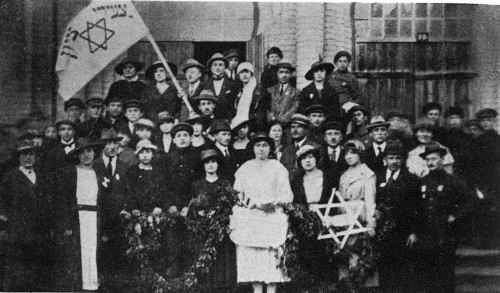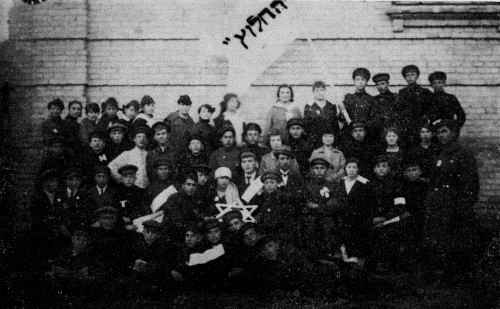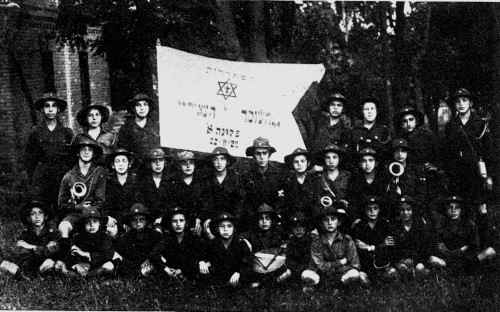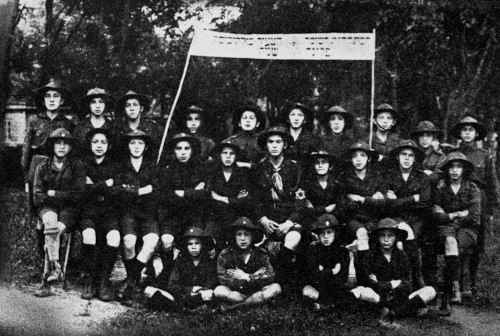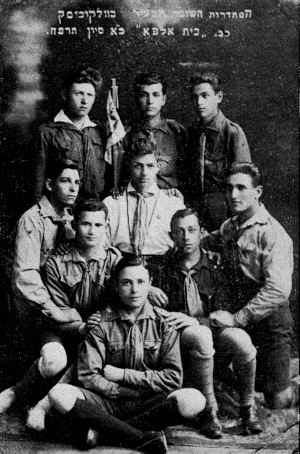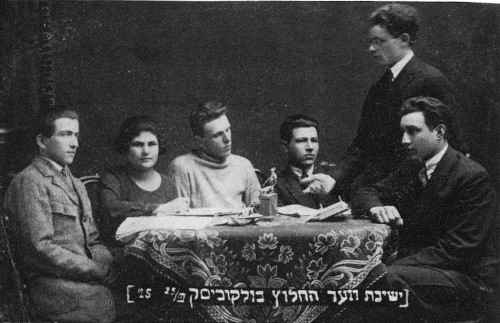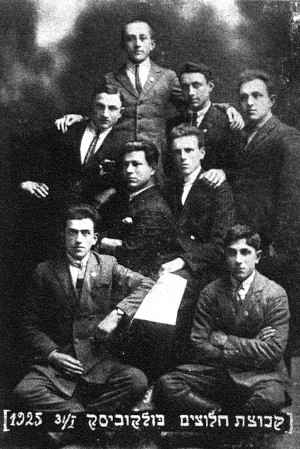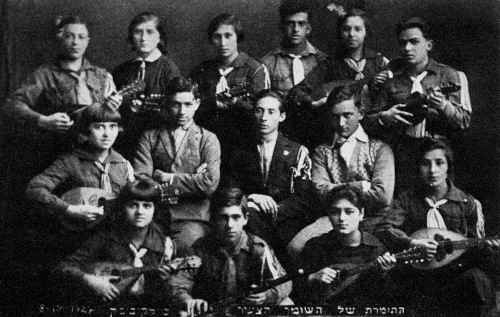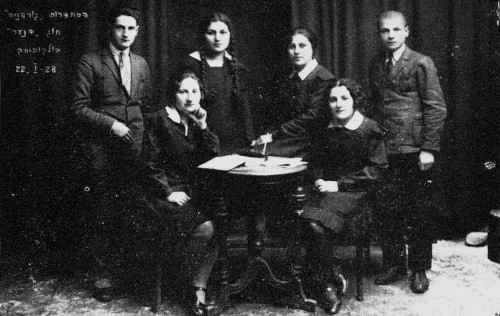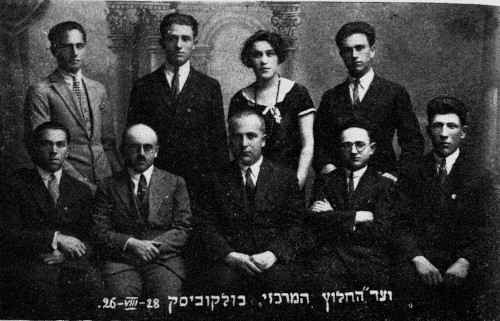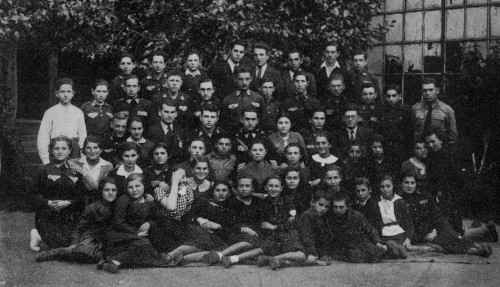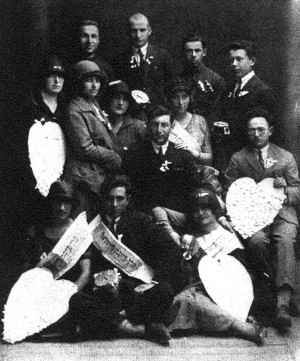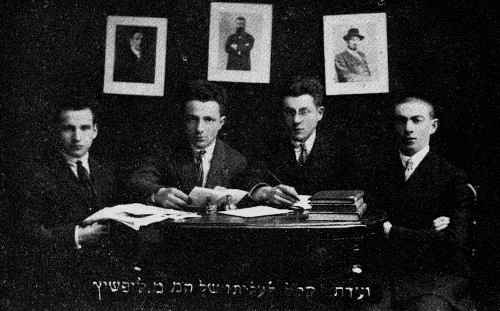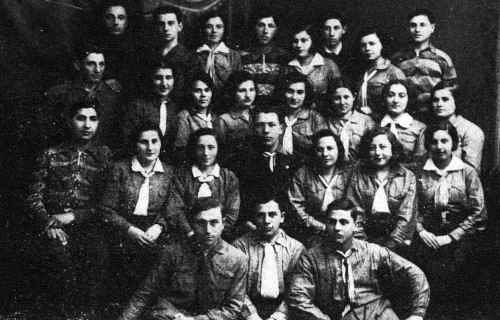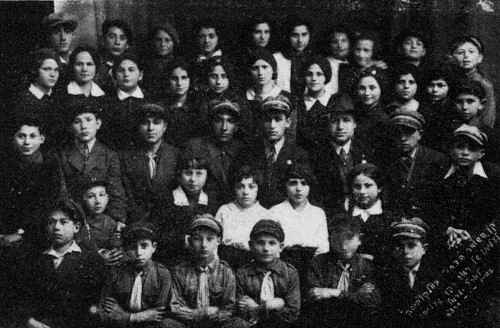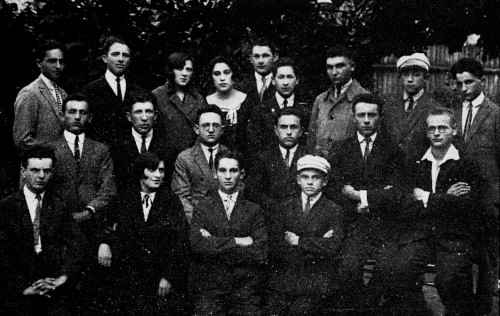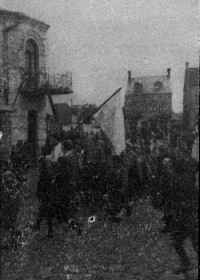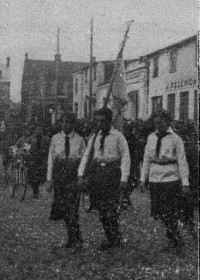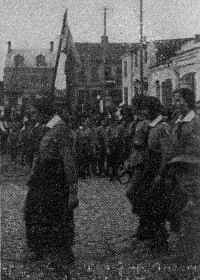[Page 56]
Zionist Movements in Volkovysk
|
|
Celebrating the Balfour Declaration in the Year 1919
Among the participants are: Zvi Weinstein (Carmeli), Anshel Bliakher, Azriel Berestovitsky (Broshi), Shprinza Bialsky, Eliyahu Mot'cheh Ginsberg, Press, Sarah & Zvi Ditkovsky, Aizik Kantzopolsky, Joseph Pines, Archik Markus, Salutsky (the Pharmacist), Yaakov Milikovsky, Gurevich, Masha Dombrovsky, Yaakov Paveh, Amstibovsky, Sarah Khvalovsky, Chana Shipiatsky, Bobeh'leh[1] Marotchnik, The two Misses Fanar, Leibl Kaplan, Daughter of the Rabbi of Piesk |
|
|
A Group of Members of HeHalutz in the Year 1920
Right to Left, First Row, from the Bottom: Y. Khomsky, Shlomo'keh Markus, Shlomo'keh Bereshkovsky, Nakhimson[2] , Chaim Yud'l Shipiatsky, Amstibovsky, Moshe Saroka
Second Row, seated center: Y. Goshchinsky, Yankel Zuckerman
Third Row, seated: Joseph Mostkov, Chaim Burstein, Ethel Lifschitz, Herschel Dworetsky, Azriel Berestovitsky (Broshi), A student (founder of the Volkovysk HeHalutz),
Shprinza Bialsky, Moshe Zelitsky, Yankel Ditkovsky, Moshe Lifschitz, unknown, Eliyahu Mot'cheh Ginsberg, Nionia[3] Khvalovsky
Fourth Row, standing: A soldier (unknown), Miss Goldberg, unknown, unknown, Kayla Schein, Munya Schwartz, Rachel Gotthielf, Feivel Dombrovsky, unknown, Moorstein, Kaplan,unknown, Hanokh Saroka, Elyeh Znaidin, Davidovsky
Fifth Row: Shmuel Einhorn, Yankel Shapiro, Ditkovsky, Herschel Podolinsky, Chana Lapin, Chan'tsheh Katzin's cousin, unknown, Lana Weinstein, Fira[4] Grodzhensky,
Manya Movshovsky, Taran, Miss Galiatsky, Baylah Galiatsky, Feygl Yunovich, Rachel Rip |
|
|
Section Aleph of HaShomer HaTza'ir in the Year 1922
Right to Left, First Row, bottom: Chaim Khvonyik, Shai'keh Werner, Mazya, Moshe Mandelbaum, 4 unknown people, Saul Markus, Liova Glickfeld, Boruch Beckenstein
Second Row, seated: Unknown, Mottel Ein, Moshe Alpert, Unknown, Sholom Hubar, Goldberg, Two unknown people, Joseph Beckenstein, Moshe Langbord
Third Row, standing: Abraham Anush, Herschel Wolsky, Yaakov Gershuni, Unknown, Moshe Savuolsky, Unknown, Berel Davidovsky |
|
|
Section Bet of HaShomer HaTza'ir in the Year 1922
Right to Left, First Row, bottom: Kaplan, Mazya, Gass, Winetsky
Second Row, seated: Unknown, Shkolnick, Beckenstein, Ein, Leibl Kaplan, Kaufman, Mopsik, Zalman Goldberg, Nakh'keh Schein, David Markus
Third Row, standing: Kaminer, Unknown, Unknown, Gandz, Moshe Langbord (Graf), Liev, Davidovsky, Shammai Wilk, Joseph Galiatsky, Mostkov |
[Page 57]
Even many years before political Zionism appeared in the Jewish streets of Volkovysk, there was a strong sentiment for the Land of Israel and its institutions, and the Volkovysk Jewish populace supported the Yeshivas and Kollel study houses with a generous hand.
Later, when Hovevei Zion began its activities, the Hibat Zion movement found many enthusiastic adherents and supporters in Volkovysk. Also, the distinguished Rabbis who occupied the seat of authority in that epoch in Volkovysk, were all ardent lovers of Zion, and they, as you can understand, strongly supported the dissemination of the idea of Hibat Zion among the Volkovysk Jews.
One of the greatest and best known of the Volkovysk Rabbis was the Gaon, Rabbi Jonathan Eliasberg, who occupied the Rabbinical Seat prior to Rabbi Abba Yaakov Borukhov. The Gaon, Rabbi Jonathan, who died at a very young age, was known not only as one of the great Torah scholars of that generation, but also as a wise man, a writer and a thinker, and all of the wise men of his generation would correspond with him, and value his opinions. In this manner, Rabbi Yitzhak Kossowsky tells – in his article, which he wrote in Hurban Volkovysk – that he found a letter written from Rabbi Sh. Y. Fein of Vilna[5], the well-known Hebrew writer for Hovevei Zion, among the books of Rabbi Eliasberg. The letter dealt with the question of an important meeting, which was called before the first Zionist Congress in Katowice, about sixty years ago.[6]
When political Zionism appeared, it found great resonance in Volkovysk, and drew to it entire cohorts of important Volkovysk balebatim, who organized themselves into a Union that took the name, B'nai Zion. In 1902, members of this organization included: Aaron Shifmanovich, Jekuthiel Roiman, Jekuthiel Novick, Aryeh Leib Markus, Moshe Mordechai Zelitsky, Shmuel Jonah Novogrudsky and Aaron Lifschitz. The Steering Committee of the Union consisted of the following people: Koppel Isser Volkovysky -- Chairman of the Committee; Shmuel Shapiro – Treasurer; Nakhum Halpern (The Teacher) – Secretary; Israel Efrat, Moshe Leib Khmelnitsky, Moshe Galai, Eliezer Yudzhik, & Shmuel David Yunovich – Members of the Committee.
At a meeting of the Union that was held in the summer of 1902, The Volkovysk B'nai Zion elected Aharon Lifschitz as their representative to the Zionist Conference, that was at that time called for Minsk.
The Zionist sentiment in Volkovysk began to assume concrete form, and in the first years of the current [sic: 20th] century, before the outbreak of the First World War, individual Volkovysk Jews emigrated to the Holy Land and settled there. Others bought parcels in the Holy Land – in the hope that they would settle there as an ultimate objective. Many Volkovysker Zionists sent their children to study at the Hertzeliya – the first Hebrew Gymnasium that was founded in the Land of Israel.
Together with the opening up of the old-world Zionist movement with all its factions and parties, many Zionist groups and circles appeared in Volkovysk, of which a few first took on a concrete organizational form only during the last years of the First World War and the announcement of the Balfour Declaration.
[Page 58]
But the general Zionists remained as the backbone of the entire Zionist movement in Volkovysk, who were the majority and accounted for most of the builders of the nationalist elements of the Volkovysk Jewish populace. The general Zionists attracted its followers in Volkovysk from among the ranks of the merchants and professional intelligentsia. The general Zionists mostly carried the burden of financing all of the important Zionist funds , such as Keren HaYesod, Keren Kayemet, HeHalutz, etc. From the ranks of the general Zionists came most of the important activists for all Zionist and national-cultural activities. A portion of the general Zionists, in their formative years, belonged to other Zionist groups – Tze'irei Zion, Kadima, Herut U'Tekhiya, etc. – but later on they confined themselves to the general Zionist movement, and worked for the dissemination of the Zionist ideal.
Among the principal activists of the Volkovysk general Zionists at various times, were: Sholom Barash, Engineer Ephraim Barash, Israel Efrat, Moshe Shapiro, Zvi Inker, Moshe Rubinovich, Yud'l Novogrudsky, Anshel Bliakher, Yoss'l Vinogradsky, Schwartz, Moshe Zvi Margalit, Ben-Zion Lifschitz, Eliyahu Shaikevitz, Asher Yudzhik, Akiva Yudzhik (brother of Asher Yudzhik), Hona Kavushatsky, Sh. Ch. Kaputchevsky, Ozer Kaplan, Leib Heller, David Hubar, Leizer Shaliota, Mordechai Tarma, Yankel Gurevich, Hanokh Neiman, Naphtali Golomb,(father of Eliyahu Golomb), Zalman Chafetz, Abraham Eli Markus, Dr. Shlomo Mandelbaum, Dr. Yitzhak Weinberg, Azhernitsky, Dr. Yaakov Sedletsky, & L. Kapelyushnik.
The Tze'irei Zion party – which was active in Volkovysk after the First World War – attracted a large proportion of the Volkovysk labor intelligentsia, and among its active membership were: Motteh-Leib Kaplan (later to become the editor of the Volkovysker Leben), Moshe Rubinovich, Zvi Weinstein (Carmeli), Yud'l Novogrudsky, and Chana Novick. The Volkovysk Tze'irei Zion carried out a variety of activities on behalf of the Hebrew school system in Volkovysk, for the national funds, and for the Zionist-Socialist movement.
It is appropriate to also record: the Zionist-Socialist Labor Party, Poalei Zion – Tz.S., and its dedicated members, such as the lawyer, Leizer Bliakher, M.A. Kushnirovsky, Eisenstein, and others; the Zionist Labor Party, Hitakhdut, with its loyal members who later, after – immediately after the HaPoel HaTza'ir and Akhdut HaAvodah merged in Israel to form Mifleget Poalei Eretz Yisrael (MAPAI) – merged with the Poalei Tzion – Tz.S.; The Zionist-Socialist youth organization, Gordonia (named for [the author,] A.D. Gordon), which had around 150 members, mostly young people of school age – with its magnificent Zionist, pioneering and cultural activities, with its choir, with its summer colonies and its facilitation of the Halutz movement; The youth organization, Freiheit (In Poalei Zion Tz.S. – Hitakhdut); The HeHalutz HaTza'ir organization, which prepared young people of the age 18-19 for membership in the general HeHalutz organization, where they later went through formal preparation and broadening, to prepare for their anticipated lives as residents in the Holy Land.
In Volkovysk (during the twenties), there also existed a Zionist-cultural youth organization called Kadima, which set as its objective the development of a pure national-Jewish spirit among the Jewish youth of Volkovysk.
The leadership of Kadima was: Yaakov Shipiatsky, Mordechai Lev, Pinchas Steinwax, Eliezer Bliakher, & Shlomo Shipiatsky. In the organization, sections were formed for Jewish and general history, for Hebrew and Yiddish literature, Tanakh, Zionist history, etc.
Kadima sponsored many assemblies and presentations, which were always attended by a significant number of Volkovysk youth. A large interest was elicited by the literary debate over Tchernikhovsky's poem Boruch
[Page 59]
MiMagentza,[7] which Kadima had arranged.
The organization Herut VeTikva also occupies a set place in the history of the Zionist movement in Volkovysk. Among its active members were: Joseph Galai, Chaim Khmelnitsky, Yitzhak Yudzhik, Raphael Ditkovsky, Raphael Klatshkin (today a well known actor, and member of the HaBima theater group in Israel). This organization had a drama studio, which was very active on behalf of the Zionist national funds, and general Zionist cultural affairs. A large number of the members of Herut VeTikva survived, because they emigrated to Israel and other countries early on.
The religious direction of the old-world Zionist movement was also found in Volkovysk. There was a Mizrachi organization in Volkovysk, who counted among its primary doers: Mr. Zvi Inker, Mr. Joseph Yervolimsky (the Shokhet), and Hona Kavushatsky HaShomer HaDati also functioned in Volkovysk – an organization of religious Zionist youth. This organization was established in Volkovysk only a few years before the outbreak of the last [sic: Second] world war, and worked under the leadership of Zelig Kagan (the Shokhet's son). During its existence, the organization did a great deal for the Keren Kayemet. At a meeting of HaShomer HaDati that took place on July 5, 1935, a leadership was elected that consisted of the following comrades: Z. Kagan – Head of the Unit; Ch. Kaplan – Secretary; M. Galai – Treasurer; Z. Minkovich – Funds and Development; Sh. Lazarovsky – Press [sic: Communications/Public Relations].
The HaShomer HaTza'ir organization occupied a visible place in the Zionist movement, which had about 150 members – mostly young people of school age. The Volkovysk [chapter] of HaShomer HaTza'ir was a vibrant organization, which arranges many presentations and spirited celebrations. Principally, the Lag B'Omer celebrations originated from them. The membership of HaShomer HaTza'ir would engage in a set course of preparation by working at the tobacco plantation, and in the factory (where wood was cut, i.e. the lumber mill), in order to prepare themselves physically for aliyah to the Holy Land. The Volkovysk HaShomer HaTza'ir had its own orchestra and a choir, and also sections for drama and Gymnasium courses.
In Volkovysk, as in all other significant Jewish communities in Poland, there existed a League for Labor in Israel, which raised money for the institutions of the Histadrut and helped to disseminate the ideals of Labor Zionism. In the League, could be found the organizations and parties with direct ties to Labor in the Holy Land; Poalei Zion, Hitakhdut, HeHalutz, Freiheit, HaShomer HaTza'ir and Gordonia. Among the principal activists of the League were: Yaakov Itzkowitz, Leizer Bliakher, Shishatsky, Director, Mordechai Sakhar, & Yitzhak Shkarlat. Other active members of the League were: L. Ziskind, R. Nishvitsky, M.A. Kushnirovsky, Pearl Sokolsky, Y. Bashitsky, A. Novick, K. Bialostotsky, & M. Tkach.
The HeHalutz organization was very active in Volkovysk. Immediately after the First World War, HeHalutz was founded in Volkovysk, and the young men of Volkovysk began making preparations for aliyah to the Holy Land. They worked at agriculture and expended effort to accustom themselves to a bucolic existence.
An interesting description of the aliyah of the first group of Halutzim from Volkovysk, in the time of the so-called ‘third aliyah’ and their experiences in the Land of Israel – was sent to us by a member of that group, Azriel Carmeli (Berestovitsky), who is now found in Tel-Aviv:
[Page 60]
“On a clear summer day in 1920, a group of ten-odd young men from Volkovysk and Lisokovo left their home towns, took their leave with the blessings of their relatives and friends, and set off on the way to the Land of Israel. We gathered on the Brisk and Zamoscheh Streets, and we traveled by wagon to Bialystok, where we were happily taken in to the local community house. When we arrived in Warsaw, we joined together with other groups, and together made our way to the Austrian border. With our departure, the so-called ‘third aliyah’ was initiated.
Our living arrangements in the Holy Land at first were not of the best kind. Immediately after we arrived in the Land, we were sent away to help build the road from Jeddah to Haifa. We were all united in one group, which had the name of our leader, Metchik. In The Land of Israel we were joined by Sonya Bialsky, who had already been there for a short while. We did no escape without casualties. One of our comrades, Ditkovsky, got sunstroke from the hot tropical sun to which he was unaccustomed, from which he became paralyzed. He was cared for in Haifa, and later in Italy, where eventually he died. Many of our comrades fell victim to malaria, and almost everyone suffered from dysentery due to the bad water, spoilage of fresh foodstuffs, and bad sanitary conditions that prevailed at that time throughout the land. Despite all of these difficult circumstances, the spirit of the group did not fall. We were of one mind, energized and full of a lust for work. During the day we would do the hardest of physical labor, and then spend the nights singing and dancing.
We were out of touch with our home city of Volkovysk for a longer period of time, because the Russian occupation interrupted the operation of the mails overseas. But our morale did not suffer. During our first year in the Land of Israel, we worked as one group on a variety of projects in different parts of the country – Beit Shean, Sarafand, Jeddah, and in the Haifa area. Our work consisted of building roads, taking out boulders with dynamite in the Beit Shean area, from which the rubble was taken by train to Afula, where it was used to put down roadbeds and railroad beds. We had our own kitchen, where we carried on with quite a bit of refinement. We slept in tents on the open fields.
When unrest suddenly broke out in 1921 at Passover time, a number of us were in Tel-Aviv where they were spending the holidays. They immediately joined the ranks of the security forces. The rest of the group, who were at their work site in Sarafand, barricaded themselves along with other comrades who were in the camp, in order to defend the place against the attack of the surrounding Arab villages.
Our group had to live together for another year. Most of the comrades spread throughout the Land – both in villages and cities. On of our dear friends, Yaakov Shapiro, a strapping young man, became a member of kibbutz Merkhavya, but he later developed a heart ailment and went back to his parents in Volkovysk, where he died at a young age. The majority of our comrades from the ‘third aliyah’ never gave up the work ethic. Ninety-nine percent of the first group of Volkovysk comrades, and also those who came after them, make a living from work of all kinds.”
|
|
The “Bet-Alpha” Group of HaShomer HaTza'ir in the Year 1928
Right to Left, First Row, bottom: Moshe'l Shereshevsky, Shepsel Poloyka, Aharon Ogulnick (Sitting first in front), Avreml Kilikovsky, Mendel Davidovsky, Head of the Unit, Yaakov Einstein (sitting center)
Second Row: Nakdimon, Miriam Hazan, Moshe Paveh |
[Page 61]
|
|
An Executive Committee Meeting of HaShomer HaTza'ir in the Year 1928
Right to Left: Shlomo Leibovich, Mirsky (standing), Yankel Ditkovsky, Hanokh Saroka, Leah Trunsky, Simcha Goldberg |
|
|
A Group of Halutzim in the Year 1925
Right to Left. First Row, bottom: Reuben Silverblatt, Simcha Goldberg
Second Row: Hanokh Saroka, Yankel Ditkovsky
Third Row: Mendel Green, Shlomo Leibovich, Ze'ev Mostkov, Moshe Langbord |
|
|
The Orchestra of HaShomer HaTza'ir with its Founder and Director
Yitzhak Alpert in the Year 1927
Right to Left, First Row, bottom: Baylah Lvovich, Henya Lidsky, Slapak, the baker's son, Tanya Pilatovsky
Second Row: Moses Mandelbaum, Yitzhak Alpert (Director), Yaakov Einstein, Bunya Levin
Third Row: Munya Silverman, Baylah Rosenbloom, Shepsel Slapak, Rosa Panter, Basha Moorstein, Kasovsky |
|
|
The Gordonia Youth Group in the Year 1928
Right to Left: Mendelson, Rachel Kagan, Sonya Smazanovich, Sonya Ravitzky, Alia Avramitsky, Herschel Lev |
|
|
Members of the HeHalutz Central Committee (In the Year 1928)
Right to Left, First Row, seated: Velvel Novick, Yitzhak Paveh, Ephraim Barash, Yud'l Novogrudsky, Moshe'l Shakhnovich
Second Row, standing: Y. Taran, Rash'eh Siegel, Joseph Gandz and Chaim Mordetsky |
The Volkovysk branch of HeHalutz served as a regional committee. Hundreds of members of the Zionist youth organizations in Volkovysk and its vicinity got their preparation and orientation for aliyah through the HeHalutz organization.
By the year 1920-1921,the HeHalutz organization was already involved with tobacco farming on larger tracts of land – not far from the Jewish hospital. Bet HeHalutz was created in Volkovysk in the year 1925-1926, on the Neuer Gasse in Rachel Ein's house, where the members carried on a collective life together, and participated in a variety of physical work in the city, such as chopping wood, construction, etc. Shortly thereafter, two kibbutzim were established in Volkovysk, whose members were at that time employed in the Volkovysk factories, mills or other lines of work. The male and female halutzim obtained their training and orientation there for the Land of Israel. The HeHalutz organization founded several agricultural work centers in the vicinity for training purposes, on Christian property, as well as the familiar training point in Mikholovka on the property of Leizer Mikholovker (Leizer Getzelevich). The Volkovysk halutzim also participated in the kibbutzim, which were located in the village of Khoroshevich, in Podoroisk, and in Josef-Paulia.
Characteristic of the relationship of the Volkovysk Jewish populace to the halutzim, is a song of Hanokh Winetsky's , called “To the Halutz” (as a farewell to his friend David Farber on aliyah to the Land of Israel) and which was published in Volkovysker Leben (December 20, 1929 edition):
[Page 62]
“You are traveling – to build a new world,
To elevate our lives,
To rejuvenate us, liberate us,
With your great and profound faith.
With a mighty, forceful will,
To transform our lives,
Ready for sacrifice, committed
To the land and national liberation.
You are traveling – to engage the land,
And to be forever united,
Tracts of land [that] long for you,
Like a child longing for its mother.
You do not fear hard work,
You do not fear sweat on your brow,
Where you [will] stand – begins the blooming
Of a desert into a Garden of Eden.
You will make – seedlings of grass to sprout in sand
And flowers to bloom in boulders,
And one hears, carried on the air:
– The resolution is at hand!”
|
|
|
A Group from Betar in the Year 1938
Right to Left, from the Leadership in the center row: Unknown, Eliezer Sukenik, Rivka Markus, Berel Velvelsky (Commander) David Linevsky, Herschel Daniel
Among the others are: Mendel Steinman, Lidsky, Khatzkelevich, Tannenbaum, Mulya Jaffa, Epstein (from Soda-water), Moshe Moorstein, Joshua Patsovsky, Shereshevsky,
Scharf, Pitotsky, Yitzhak Tzemakh, Rachel Pilatovsky, Tzil'yeh Mazover (from the Wurst), Tcherneh Rossiansky, Golda Werner, Zhameh[8] Marantz,
Chas'sheh Boyarsky, Golda Markus, Chaya Galai, Ida and Fanya Mazover (from the Paper business), Chaya Sukenik, Tzirulnitsky, Shalkovich, Esther Beckenstein, Rosa Sukenik, Rivka Rothford, Slutsky, Rachel Markus, Dorochinsky |
|
|
Flower Day for Keren Kayemet
Right to Left, First Row, bottom: Rosa Kaplan, Archik Shapiro, Miss Friedman (der Mostorkeh's[9] daughter)
Second Row: Yitzhak Paveh, Chana Dombrovsky, Fishl Mirsky, Yakheh[10] Zapoliansky, Rachel Rip, Miss Gurevich
Third Row: A. Novick, Yitzhak Alpert, Shlomo Shipiatsky, Zelig Kagan (the ritual slaughterer's) |
[Page 63]
|
|
Members of the Keren Kayemet Committee in the Year 1924
Right to Left: Shmuel Markus, Elchanan Yoshpeh, Moshe Lifschitz, Shlomo Shipiatsky |
Among the first of the active members of the Volkovysk HeHalutz were: Moshe Shapiro's son and Zelitsky's son. Among the principal active workers of HeHalutz, from various periods were: Avreml Novick, the Saroka Brothers, Moshe'l Shakhnovich, Ditkovsky, Leizer Zamoschansky, Taran, The Paveh Brothers, Mendel Solomiansky, The Pick Brothers, Yerusalimsky (the Shokhet's son), Rash'eh Segal and Yitzhak Shkarlat.
There also existed in Volkovysk a Halutz organization called HeHalutz HaMercazi, supported by the right wing of Zionism. The Honorary President of HeHalutz HaMercazi was Engineer Ephraim Barash, and President – Velvel Novick. Among the noted members of the organization were: Joseph Gandz and Izzy Mintz. The central authority of HeHalutz HaMercazi built training and preparation points in the Volkovysk vicinity for the HeHalutz HaMercazi membership from the entire area of pre-War Poland.
In the last years before the outbreak of the Second World War, in many countries, but primarily in Poland, a new pioneering organization was created named HaOved. This immediately elicited a reaction in Volkovysk, and a chapter was established there. Working people and their families, in the age group 30-45 immediately joined this organization. [There were] people who had been associated with the Zionist movement since their youth, and wanted to prepare themselves for life in the Holy Land. After a period of tenure – members of HaOved could receive certificates from their organization to make the trip to the Land of Israel. As it happened, their lives were forfeit before they were able to put their plans into action.
The Zionist Revisionists were also represented in Volkovysk. The leading activist in Volkovysk on behalf of the Zionist Revisionists was Engineer Yaakov Shipiatsky. Under the Zionist Revisionists there also existed: the youth organization Betar, consisting mostly of young people from the Gymnasium (The Chapter Head – Sh. Zohn-Mazya); Masada, Brit HaKhayal – in which the previously mentioned Engineer Shipiatsky and Appl[icant][11]. Mezheritzky were very active. The Revisionists and their sympathizers devoted a great deal of their energy and time to the Revisionist fund, Keren Tel-Chai.
To see how much Volkovysk was a center for Revisionist Zionism until the very last years prior to the Second World War, can be seen from the following notice – about a Tzahar conference and a Betar conclave in Volkovysk – which was published in the Volkovysker Leben of May 14, 1937:
“On Sunday, the 23rd of this month, a conference of Tzahar and a Betar conclave will take place in Volkovysk, with the participation of the General Secretary of the Revisionist party in the Polish district, Y. Klarman. The agenda contains a list of real issues, and as a result we anticipate the attendance of many delegates and guests from the province.”
[Page 64]
The Zionist Ladies Organization, WIZO (founded in 1934) played an especially important part in the Zionist movement in Volkovysk, which encompassed a broad set of cultural and community activities. The leading activists in WIZO were: Dr. Jocheved Barash, wife of Ephraim Barash – President of WIZO, Chaya Sarah Yudzhik, wife of Nakhum Kroll the Pharmacist, Feygl (Galiatsky's daughter) and Mrs. Mostkov.
WIZO often arranged bazaars for the benefit of Keren Kayemet. The WIZO ladies would assemble merchandise from the Volkovysk storekeepers and also from businesses in other towns – who were suppliers to the Volkovysk storekeepers.
WIZO also created courses in Zionism and also arranged a variety of lectures at the community house. During Purim and Hanukkah, WIZO also would organize a variety of events and balls – in the firehouse. The WIZOballs were especially popular during which a “Jewish Miss Volkovysk” was elected. During one such ball, Baylah Galiatsky was elected Beauty Queen of Volkovysk.
Apart from arranging various events for Keren Kayemet, children's holiday activities and leisure activities, WIZO also, according to an item in the Volkovysker Leben (from the year 1935) – arranged a children's retreat for the summer months. The newspaper writes:
“Nearly a hundred children from very young to school age, spend four to five hours each and every day in the fresh air in song and play, under the supervision of two teachers in training, who immediately after the end of the semester of the Hebrew teachers seminary, applied their energies and education in the vacation months for this purpose (incidentally, former students of the advanced Hebrew educational institutions , who brought the product of their labors to the children).”
It is understood, that in Volkovysk – where there existed such a strong and vibrant Zionist movement – that much money was gathered on behalf of the national funds. Even in the year 1929, the sum of 9,545.63 zlotys were donated in Volkovysk to the Keren HaYesod – almost double what was given in the prior year (in which 5,463.20 zlotys were given).
According to an announcement from the year 1932, the Chairman of the Keren HaYesod was Engineer Ephraim Barash, and the Vice-Chairman – Zvi Inker.
Because of the significant role that Volkovysk played in the Zionist life of Polish Jewry, Volkovysk was often visited by the most important leaders of the Polish Zionist movement and its central institutions. It was thus, for example, that in the year 1932, in the interest of Keren HaYesod, Volkovysk was visited by the Chairman of the Keren HaYesod directorate of Poland, Mr. Asher Kolodny, and also the renown Jewish historian Dr. M. Shipper, who gave a lecture.
As late as June 1939 – shortly before the outbreak of the Second World War, which sealed the fate of the Jewish community of Volkovysk with certainty – the Chairman of the directorate of the Keren HaYesod in Poland, Yaakov Bialopolsky – came to Volkovysk representing the interests of Keren HaYesod. The Chairman of the Volkovysk [branch of] Keren HaYesod at that time was Zvi Inker. Bialopolsky spoke on the theme: “Our Response to the White Book.” Among those gathered for the Keren HaYesod initiative of that year, the following stood out: Zvi Inker, Moshe Rubinovich (Community Head), Anshel Bliakher, Dr. Shlomo Mandelbaum, David Salistovsky, Joseph Vinogradsky, Dr. Yitzhak Weinberg, Mr. Wolfstahl (Director of the Tarbut Gymnasium), and Mr. Walkin.
[Page 65]
Those active in the Volkovysk Zionist movement also worked loyally and with commitment for Keren Kayemet. By 1925, the sum of 8,700 zlotys had already been raised in Volkovysk on behalf of Keren Kayemet, and in the year 1930 – 9,231 zlotys.
Among the activists on behalf of Keren Kayemet at various times were: M. Lev, Y. Shipiatsky, A. Shaliota, Yud'l Novogrudsky, D. Kaplan, V. Novick, Y. Gandz, L. Trinsky, Yitzhak Yudzhik, H. Kovensky, K. Gagarin, Moshe Shapiro (who for a while was the Treasurer of the Volkovysk Keren Kayemet), Aaron Lifschitz, Miss Mostkov, Wald, Yitzhak Shkarlat, B. Beckenstein, Y. Goldrei, and Mordechai Tarma.
Entire generations were raised in Volkovysk with the ideals of the Keren Kayemet – from the fund which acquires parcels of land held by foreigners and transfers them to the aegis of the entire Jewish nation. It is in this way, that we find among the names of the Volkovysk activists during various times the names of Sholom Barash and his son, the Engineer, Ephraim Barash.
Regional conferences of the Keren Kayemet would take place in Volkovysk, in which the leaders of the Keren Kayemet throughout Poland would participate.
As we have already noted, the Volkovysk Zionist activists would arrange very substantial celebrations during the Jewish holidays, which served as a highly influential means of disseminating the Zionist ideal, and also as an important fund raising mechanism for the national funds. Separately arranged was the traditional Lag B'Omer Celebration, which culminated in a very large demonstration put on by the Zionist youth, leaving a very strong impression on the entire Jewish populace. Thus, for example, we read in the Volkovysker Leben (No. 112) about the “Grandiose Lag B'Omer Celebration” which took place in 1929:
“The celebration commenced on Monday evening, the night before Lag B'Omer, with a parade by HaShomer HaTza'ir with the firefighters' orchestra at its head, through the streets of the city.
On the morning of Lag B'Omer, a festive meeting took place in the Great Synagogue, which commenced with a prayer offered by the Shokhet and Meat Inspector Rabbi Israel Reuben Kagan. Mr. Shkarlat held forth with an emotional and glistening speech in Hebrew on matters of the day, and the choir, accompanied by the orchestra, sang nationalist songs.
Afterward, a line formed from the entire body of the school-age children together with the Zionist youth organizations, HaShomer HaTza'ir, HeHalutz, and Gordonia, with their banners and standards, which then marched through the streets with the orchestra at its head to the outskirts of the town.
Arriving in the fields, the young people spend the day productively in song and dance and towards evening, marched back to the city.
After a final ceremony at the Schulhof, the entourage dispersed.
The management of the celebration was primarily due to the energetic work of the Keren Kayemet commission under the leadership of Mr. Zelig Kagan, at its head, and the special events committee for the Lag B'Omer celebration.”
From an earlier edition (No. 111) of the Volkovysker Leben, we learn that on that Lag B'Omer, a special fund raiser was conducted in the city, and also a “one-day fund raising activity among the working intelligentsia for the benefit of Keren Kayemet Le'Yisrael. ”
[Page 66]
All the Shomrim of Volkovysk came to the Lag B'Omer celebrations.
We find an interesting description of a Lag B'Omer celebration of another year, in the Volkovysker Leben:
“This year's celebration, in honor of Lag B'Omer, organized by the local Keren Kayemet Committee, was exceptionally imposing and masterfully run, so much so, that it elicited great wonder among the attending public, both Jews and Christians [alike].”
It was an authentic national youth holiday in the fullest sense of the word.
The celebration began on Monday evening with a march through the streets by HaShomer HaTza'ir, led by a brass orchestra.
Early on Tuesday morning, HaShomer with its standard, as also Gordonia and its membership, the Jewish student body from the “Hertzeliya” Gymnasium, the Hebrew School, Talmud Torah, The Orphanage, Private Heders, and the Kindergarten, along with its teachers, all gathered at the Schulhof, fell in by groups into rows with Jewish and Polish flags, and from there in an orderly, diverse and long row, marched through the streets under the music of the orchestra in the direction of the Burkehs[12].
The managed order, the controlled pace of the march, the beautiful, enchanting uniforms of the HaShomer youth, and most of all, the light, yet disciplined and proud stride of the Shomrim made a colossal impression on the surrounding spectators, who derived enormous nachas from just watching.
In the woods, the marching column bivouacked for the entire day, and spent the day in song and other diversions.
At six in the evening, the entire holiday crowd of marching young people came back from the woods, and after a closing ceremony at the Schulhof, the grand column dispersed, leaving an impression and unceasing joy and inspiration with the participants.”
The Jewish populace of Volkovysk, steeped in nationalist ideals, literally lived and breathed with the Jewish settlement in the Holy Land. Every important event in the Land of Israel immediately elicited a reaction in Volkovysk, and strongly influenced Volkovysk Jewish life. We find an interesting description of the reaction of the Jewish populace in Volkovysk to the anti-Semitic unrest in the Holy Land in 1929 in the Volkovysker Leben (September 6, 1929 edition). We will reproduce this description here – entitled “Volkovysk Under the Pressure of the Bloody Events in the Holy Land” – with minor omissions:
“Into the stricken atmosphere which enveloped the entire Jewish population because of the bad news, which arrived from the Land of Israel, there came some comfort at the end of the last week, brought by news carried in the Warsaw press.
But by Saturday, the atmosphere deteriorated yet again, because of radio broadcasts about the frightful bloodbath that wild Arabs perpetrated in Tzfat[13].
[Page 67]
Under the still-fresh impression of this new atrocity, a gathering did come together of a majority of the local balebatim, which was called for on Saturday night in the location of the orphanage, through the initiative of the Zionist organizations, community and Rabbinate, with the purpose of establishing an Aid Committee for the benefit of the victims.
---- On the spot, a sum of three hundred dollars was allocated and a committee of 30 people was put in place. Immediately following this gathering, the committee had its first constructive meeting. Rabbi Yitzhak Kossowsky was elected Chairman; Vice-Chairmen – A. Schlossberg, Eliezer Shaliota, and Ozer Kaplan; Treasurer – Engineer E[phraim] Barash.
---- During the week, members of the committee visited Jewish homes and raised eight hundred dollars. ---- the local Jewish population, without regard for their [political] position or orientation, understood its need to fulfil its responsibility to the victims in the Holy Land, and demonstrated a true fraternal feeling to the fund-raisers with larger or smaller contributions ---- each according to his means.
A huge protest meeting took place on Monday in the Great Synagogue about the bloody events that took place in the Holy Land. For this reason, stores and places of business were closed from 4PM on throughout the entire city.
After the Cantor Mr. Stashevsky from Baranovich recited a series of appropriate chapters from the Psalms, the Rabbi eulogized the fallen martyrs in our Holy Land. The eulogy, which lasted over two hours, was a true masterpiece, and elicited a bitter lamentation from the audience of three thousand people.
The audience broke out into an especially pitiful wailing at the time that Cantor Stashevsky sang a memorial for the martyrs. Many fainted, mostly the women in the women's gallery.
After the memorial service, the Rabbi spoke once again, and demanded that everyone make a greater effort on behalf of the Holy Land, which will be – he said – our best response to the feral onslaught of the Arabs.
Mr. Yehuda Novogrudsky, and the pioneer Moshe Weinman also spoke to the audience in Shushchik's yard, near Volkovysk, and many protest resolutions were approved.”
The meeting adjourned with the singing of HaTikva.
Also, at the time of the British Mandate (in the year 1939), when the “White Paper” was issued with its decrees against the Yishuv, Volkovysk stormed with upset and protest.
In this fashion, a variegated Zionist activism prospered in Volkovysk. There was not a branch of the Zionist world movement that didn't have at least a small branch in Volkovysk, and the Volkovysk population was rich in. creative and productive elements on the matter of cultural and Zionist activity.
It is appropriate to recall here the building which in the years after the First World War served as the focal point for the widely branched pioneering, cultural and Zionist organizational activities for Volkovysk – The Beth Lehem on the Schulhof. This building had been first constructed by the well-known Volkovysk philanthropist, Nakhum Heller. During the time of the First World War, and immediately thereafter, the building served as a subsidized kitchen for the poorer Jewish population in Volkovysk, especially for poor children. The kitchen at that time was supported by the “Joint” and by private Jewish contributions. This very
[Page 68]
building was initially under the supervision of Leib Heller (brother of Nakhum Heller) and afterwards under Aaron Lifschitz (Nakhum Heller's brother-in-law). The entire premises was later turned over to the Zionist movement. In it were found the offices of: Keren Kayemet, Keren HaYesod, The General Halutz Organization, The Zionist Youth Organization, Gordonia, The HaShomer HaTza'ir Organization, The Volkovysk branch of the Israeli office in Poland, the Free Public Hebrew Tarbut Library, and many other Zionist institutions and organizations. The place always pulsed with a full-blooded Zionist life.
Volkovysk was often visited by the highest Zionist leadership from the Land of Israel and other countries, who would come to give speeches there on behalf of the national funds and Zionist ideals, and they always attracted a large enthusiastic audience. In the great calamity that befell Polish Jewry the vibrant Zionist life in Volkovysk was also eradicated from the face of God's earth.
|
|
Members of the Zionist-Socialist Youth Organization “Gordonia”
Right to Left – First Row, bottom: Hanokh Pick, Gottleib, Rosenbloom, David Aaronson
Second Row, seated: Minia Greengass, Chana Friedlander, Chaya Rakhkin, Abraham Novick (Leader and Chairman), Taib'l Mopsik, Pessia Mordetsky, Yehuda Galai
Third Row, standing: Riva Rock, Esther Galai, Minia Yellin, Feygl Rotberg, Esther Goshchinsky, Ethel Lichtin, Chasia Weinstein, Aharon Sukenik
Last Row: Gideon Pick, Batya Steinman, Gedalyahu Kaplan, Dvora Rosenbloom, Rossiansky, Fruma Shabrinsky, Leibovich, Eliezer Minkovich |
|
|
Membership of the Religious Zionist Organization “HaShomer HaDati” in the Year 1935
Right to Left – First Row, bottom: Boruch-Mordechai (last name unknown), unknown, Epstein, Chaim Ozer Einhorn, Yehuda Rossiansky, Boruch Orlansky
Second Row: Gurevich, Bayer, Winetsky, Winetsky (a sister), Kapelyushnik
Third Row, seated: Mordechai Kapchevsky, Michael Galai, Zelig Kagan (the Shokhet's), Gedalyahu Levin, Sender Kaplan, Menachem Binkovich, Joshua Linevsky, Hanokh Rappaport
Fourth Row, standing: Galai, Pisetsky, Markus, Epstein, Malka Levin, Cantor, unknown, Schwartz, Yunovich, Winetsky, Winetsky (Abba Yehuda's daughters)
Last Row, standing: First – Moshe Kossowsky, Last – Chaim Kaplan ( from the Wide Boulevard) the rest of this row is not identifiable. |
|
|
Members of the HeHalutz Committee Together With A Group of Halutzim from Lodz
Among the Volkovysk members found in this picture, are the following:
Right to Left, Center Row, seated: Two people from Lodz, Velvel Taran, Yitzhak Paveh, Velvel Novick (Chairman of HeHalutz in Volkovysk)
Back Row, standing: Four halutzim from Lodz, Izzy Mintz, Rash'keh [sic; Rash elsewhere] Siegel, A young lady from Lodz, Joseph Gandz, Chaim Mordetsky |
|
|
|
|
|
|
A Parade of HaShomer HaTza'ir on the Wide Boulevard
(Three panels, untitled) |
Translator's footnotes:
- Diminutive for Bobeh from the Czech-Christian, Baba. Return
- It is not possible to tell if this name should be Nakhinson, or is truly distinct. Return
- Niona is one of the Yiddish diminutives for Binyomin (Benjamin). Also see ‘Nioma’. Return
- Either from Piryah (fruit), or Tzippora Return
- Referred to previously, and elsewhere, by the acronym of his name, the Rashi of Vilna. Return
- Given that the Einhorn book was published in 1948, the reference is to the late 1880's Return
- Boruch of Mainz, an epic poem by Saul Tchernikhovsky, describing the great pogrom in Mainz in medieval times. Return
- Nickname for Shimon. Return
- Seemingly a pattern-maker for dresses. Return
- Variant of Yokheh, from Yocheved. Return
- An Applikant in Polish, is someone who is preparing themselves as a specialist. This term seems to be equally applied to physicians and lawyers, but may be used for anyone who is an apprentice. Return
- An area on the outskirts of the city, in the local woods, used for recreation. Return
- Rendered Safed in English Return
This material is made available by JewishGen, Inc.
and the Yizkor Book Project for the purpose of
fulfilling our
mission of disseminating information about the Holocaust and
destroyed Jewish communities.
This material may not be copied,
sold or bartered without JewishGen, Inc.'s permission. Rights may be
reserved by the copyright holder.
JewishGen, Inc. makes no representations regarding the accuracy of
the translation. The reader may wish to refer to the original material
for verification.
JewishGen is not responsible for inaccuracies or omissions in the original work and cannot rewrite or edit the text to correct inaccuracies and/or omissions.
Our mission is to produce a translation of the original work and we cannot verify the accuracy of statements or alter facts cited.
 Vawkavysk, Belarus
Vawkavysk, Belarus
 Yizkor Book Project
Yizkor Book Project
 JewishGen Home Page
JewishGen Home Page
Yizkor Book Director, Lance Ackerfeld
This web page created by Jason Hallgarten
Copyright © 1999-2026 by JewishGen, Inc.
Updated 25 Sep 2022 by LA
